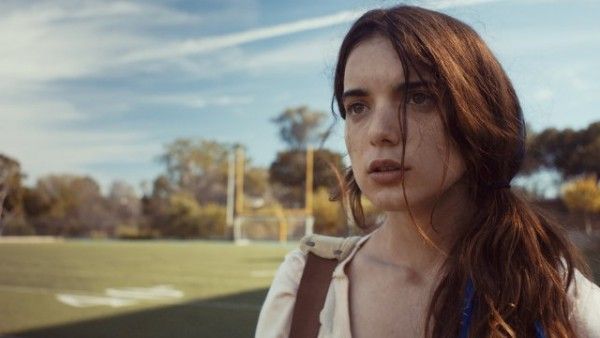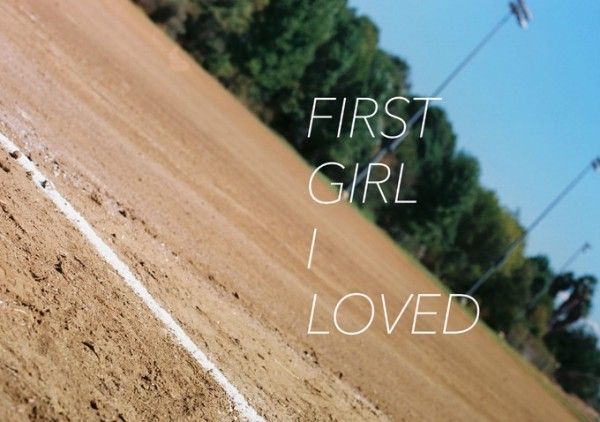A collage of a time half-remembered, First Girl I Loved is the ‘high-school yearbook’ of teen romances, skipping around (sometimes haphazardly) through events, replaying scenes, moments, memories – revealing new details with each replay. It’s telling that the scenes the film chooses to repeat are either the most traumatic or the most pleasurable, mirroring the tendency to fixate on the binaries of life. At times the elliptical, repeating nature of the film confounds rather than enlightens. It takes awhile to get on First Girl’s particular wavelength but once you give yourself to its rhythmic, hazy aesthetic, the film reveals itself to be an earnest and sweet look at burgeoning love.
First Girl I Loved repeatedly returns to two key moments – an early drunken conversation between high-school best friends Anne (Dylan Gelula) & Clifton (Mateo Arias), in which Anne confesses her feelings for another girl, and then later when Anne and the object-of-her-affection, Sasha (Brianna Hildebrand), have a sleepover. These two moments become the backbone of the film, informing every action that occurs before and after. The ramifications of Clifton & Anne’s conversation at first appear to be your standard ‘boy-upset-girl-likes-someone-else’, but the moment becomes far nastier and more unpleasant with each repeated viewing; whereas the sleepover takes on an almost mythical status – shot in bright reds & greens, the morning light peering through half-closed shades, the camera lingering on the two girls’ entwining hands.
These moments are emblematic of how the film’s lead – Anne – perceives these memories: the first a terrible betrayal from someone she thought she could trust and the latter, the time she fell in love. First Girl I Loved is a coming-out story where memory dictates our own emotional resolve, these two moments clarifying just how Anne feels about men and women. The film isn’t just about Anne though – it’s also about how Clifton and Sasha view these exact same memories and how their perception skews from Anne’s. First Girl I Loved isn’t Rashomon. It’s not interested in the uneasy nature of memory and how people shape their own past. Instead memory here is the constant – unchanging and inflexible. It’s how we choose to interpret them and how these memories inform who we become that changes from person to person.
There’s a terrific scene between Clifton and a guidance counselor (Tim Heidecker) where he confronts just what happened in that moment between Anne and him, the regret he feels and the unshakeable knowledge that he’s done something so terrible, that there’s no way he can he ever be forgiven. Similarly the climax of the picture focuses on Sasha’s own recollections of the sleepover. How does she feel about what happened? Does it mean as much to her as it does to Anne? Does the memory have any lingering effect at all?
In First Girl, the myopic nature of memory becomes a rally cry for self-identification. If a memory can mean a thousand different things to any number of people, than its specificity to an individual defines them. Which is to say if you remember an event as being happy, that doesn’t necessarily mean the event was happy, but that you were happy in it. It’s in this specificity that Anne finds solace, Clifton finds despair and Sasha finds confusion, each character defining themselves through their own recall.
Often teen sexuality (especially female) can feel exploitative coming from a male filmmaker (see Blue is the Warmest Color for proof); but filmmaker Karem Sanga wisely leans towards the more conservative side. Anne and Sasha’s relationship is handled very gently, all wistful looks and smiles and touching feet and closed kisses. For a film that tackles such weighty subjects as consent & homophobia, First Girl I Loved never gets bogged down in melodrama. It’s a kind film – heartfelt and empathetic – a memory more than earned.
Grade: B
Click here to catch up on all of our Sundance 2016 coverage thus far, and peruse our other reviews below.
- Audrie & Daisy
- The Birth of a Nation
- Captain Fantastic
- Carnage Park
- Christine
- Equity
- The Free World
- The Fundamentals of Caring
- Goat
- The Hollars
- Holy Hell
- Hunt for the Wilderpeople
- Indignation
- The Intervention
- Kate Plays Christine
- Love & Friendship
- The Lure
- Manchester by the Sea
- Morris from America
- Newtown
- Norman Lear: Just Another Version of You
- NUTS!
- Other People
- Richard Linklater: Dream Is Destiny
- Sing Street
- Sleight
- Southside with You
- Swiss Army Man
- Tickled
- Under the Gun
- Under the Shadow
- Weiner
- Yoga Hosers



